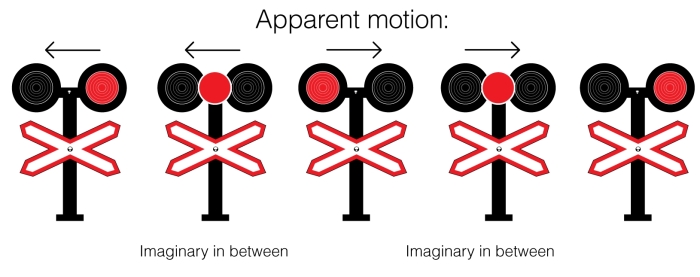The animation (and motion pictures as a whole) is based on the human ability to perceive the so called apparent motion . It is not based on the real continuous movement of an object, which should exist on each point of the motion trajectory, but on the phase positions of an object, which exist only on the extreme positions of the trajectory. Everything in between is imagined by the brain (when the visual system creates the in betweens at wrong positions, illusions such as the wagon-wheel effect occurs). A good example of the apparent motion is the rail crossing semaphore with two alternately flashing lamps. The signal may look like lights moving left and right, although in reality, there is no physical movement of the lamps. Recall any neon sign with, for example, moving chains of lamps or animated flipping books. Thence, it is quite easy to convince a person that something is moving because the vision system is very dubious and always tries to catch clues that something changes its positions.
Vilayanur S. Ramachandran and Stuart M. Anstis in their article The Perception of Apparent Motion, published in Scientific American (June, 1986, Vol. 254, No. 6), gave the following pictorial explanation of the apparent motion's origin:
"In the real world anything that moves is a potential predator or prey. Hence being able to quickly detect motion and determine what moved, and in what way, is crucial for survival. For example, the ability to see apparent motion widely separated images may be particularly important when detecting the motion of animals that are seen intermittently, as when they move behind a screen of foliage or a tree trunk."
The following figure shows how apparent motion works:

The phi phenomenon, which was defined by psychologist Max Wertheimer in 1912 and later became the basis for the cinema theory, is a special case of the apparent motion and it directly describes the principle of motion pictures: a series of separate still images with some common elements appearing rapidly creates an illusion of complex motion. In other words, by showing individual frames with specific frequency, it is possible to fill them with breath and give them life. The sprite animation in games is based on phi phenomenon as well. Game engines show separate frames in continuous succession, but players perceive it like a live scene. Hence, to create an illusion of motion on the screen, you need several main phases and the correct frequency, which is very important because the convincing of the phi phenomenon is directly related with the time between phases. The illusion can be totally broken if the frequency is too low. For example, when the length of time between frames becomes longer then 500 ms, it is more likely for images to be interpreted as individual pictures rather than part of a single scene.
The traditional frame rate for motions pictures, which appeared with the introduction of the sound cinema, is 24 unique frames per second (the projection frame can be higher, 48 FPS or 72 FPS, which means that each unique frame is shown twice or thrice). There are many debates about this value, but unquestionably, it gives the familiar "cinema experience," which looks more genuine than pictures shot on video cameras; video cameras utilize higher frequencies. You can use 24 FPS for your animation. The result will be spectacular and very smooth, and all gestures will be very fluent. But, on the other hand, it will require more efforts on animation development (mainly on its fine tuning) and sprite sheets files will be larger. If everything is critical to your project, meet the requirements half way: reduce the frame to 12 FPS. For a long time, many traditional animated masterpieces were "shooting on twos." Despite the fact that such animation features were played at the normal cinema speed, in reality, the unique frames were burned on film twice. So, there were only 12 unique images per second, but they were displayed longer to fit the 24-FPS format. This was possible because 12 frames is nearly minimum comfort frame rate to perceive motion. Although it is not ideal, it is considered pretty satisfactory.
